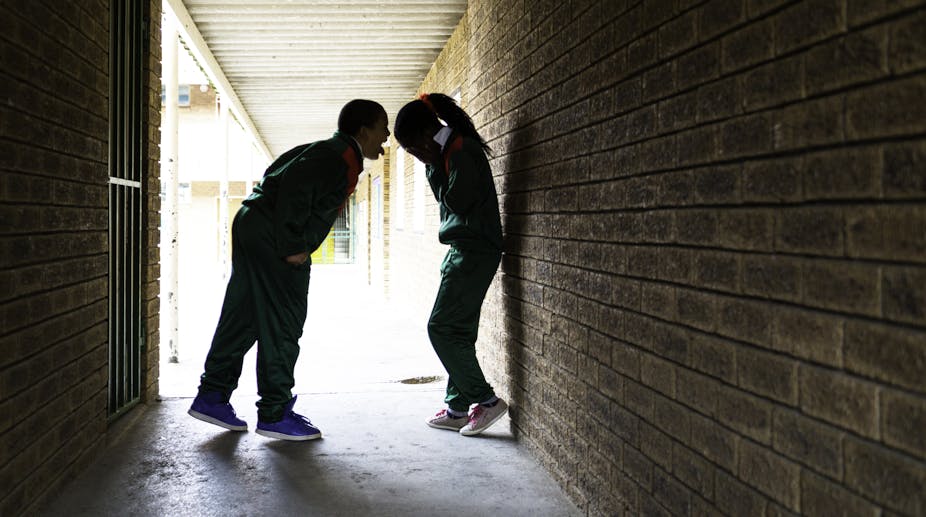“Pupil stabbed to death at Gauteng school had suffered history of bullying”. “Grade 6 learner commits suicide after bullying”. “Grade 11 learner takes her own life after taunts over her appearance.”
These are just some headlines about the occasionally tragic effects of violent school bullying in South African schools – and, unfortunately, the problem runs deep. In 2015 the Trends in International Mathematics and Science Study, which also collects information on the factors that affect academic performance, found that 64% of South African grade 9 learners (most aged between 14 and 16) experience bullying (social, verbal, physical or cyber) on at least a monthly basis. A similar rate, 65%, was found in 2019.
The Department of Basic Education introduced the National School Safety Framework in 2015. This aimed to empower schools in identifying and addressing security threats, aligning with international conventions and national legislation on child rights and safety. It draws on substantial policy frameworks, including several key pieces of legislation. However, this framework has had limited effects.
Now, in what seems like a last resort, the department is promoting the use of Section 2(4) of the Protection from Harassment Act. It empowers children to apply for a protection order without their parents’ help.
I am an education policy analyst and, over the past decade, I have focused on how school environments affect learner achievement. Parts of any school’s environment are the quality of relationships among learners, feelings of safety, learner’s sense of belonging, and the prevailing attitudes and values of learners and teachers. My research thus includes school bullying. My work explores factors influencing bullying and its outcomes, informing policies for safer schools. Research I’ve conducted with colleagues on the nature of bullying in South African schools unfortunately shows that such measures are likely ineffective.
That’s because bullying is complex. Our research findings point to cycles of bullying where learners can be victims of bullying in some contexts and perpetrators in others. We call these learners bully-victims. When they are repeatedly victimised, some individuals – seeking power and control – turn to bullying as a coping mechanism. Our results provide evidence that bullying and victimisation should not be thought of strictly as opposing behaviours, but as a symbiotic relationship. Understanding this complexity is important for shaping effective anti-bullying programmes, which should focus on the school as a system rather than on individual learners.
What learners told us
Our study drew from self-reported data provided by 12,154 grade 9 students who participated in the Trends in International Mathematics and Science Study in 2015. Its purpose was to understand the risk factors associated with being a victim of bullying and the relationship between perpetrators and victims. It was the first nationally representative study of this kind, where learners were asked about the types of bullying that they were victims and perpetrators of.
We found that for all forms of bullying, being a perpetrator was significantly related to being a victim of bullying. This was true for being made fun of (verbal bullying), being hurt (physical bullying) and being left out of games (relational bullying). The highest odds were found for having information posted online (cyber bullying), students being forced to do things that they did not want to do and students being threatened. Learners who had information about them posted online were 13 times more likely to post information online about others.
Read more: Why girls continue to experience violence at South African schools
The findings indicate that it is important to identify bully-victims as a distinct group from those who are just victims or perpetrators. Bullying and victimisation should not be thought of strictly as opposing behaviours. This will help policymakers and schools to design appropriate interventions.
What lowers the risk of bullying?
An important finding in the study is that the school environment, or at least the students’ feelings towards the environment, was associated with bullying behaviour.
Read more: Schools can be a great resource for mental health in South Africa
Students who reported feeling secure and that they belonged at school were less likely to be bullied. Students who felt exposed to unfair treatment by teachers were more likely to be bullied. These trends were very similar across the types of bullying. It is clear that school principals and teachers need to foster a positive and inclusive school environment where all students feel valued and supported.
Students should also be encouraged to get involved in building a positive culture. This could lead to the co-creation of schooling norms that build values and protect learners.
Parents have an important role to play, too. The Department of Basic Education has resources available such as “Tips for Parents”, which shows parents how to teach children about different forms of bullying, how to recognise it, and the importance of reporting any incidents. The booklet also describes the warning signs of being bullied. Some of these tips include assuring children that you will immediately investigate and report the situation with the school principal rather than trying to be a “fix-it” parent by calling the bully’s parents.
Targeted programmes
In the pursuit of safer schools, the discourse must move beyond awareness to designing targeted programmes that are based on evidence. Only through such comprehensive insights can we hope to develop strategies that genuinely resonate with the complex realities faced by students in the country.

